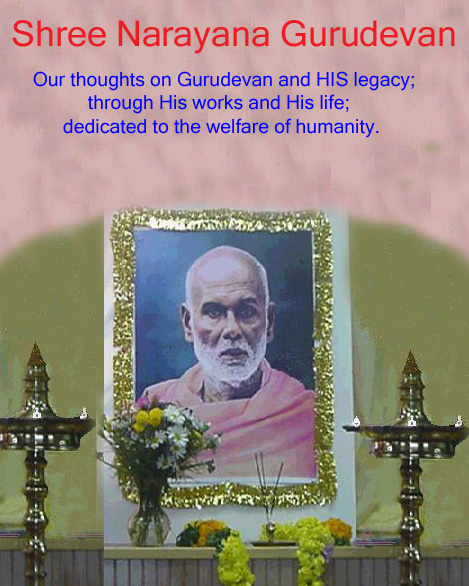In
order to obtain the full benefits of our Rishis’ (ഋഷികളുടെ) (Spiritual Masters’) words and deeds,
we have to look at their words and deeds together in a wider magnitude. We
should also look at its greater implication on a much wider canvas and
understand them.
In
simple terms an idol in a Temple is an object of warship as a representation of
the Absolute (braHMam - ബ്രഹ്മൻ). So, when we go to
Temple we feel we are worshiping The Ultimate, through an idol which represents
the Devatha (ദേവത) it represents, depending on the
Spiritual progression of the individual worshipper. In the case of an Adwithi
(അദ്വൈതി) any
idol is a representation of anything and everything, because for Adwithi
(അദ്വൈതി),
braHMam (ബ്രഹ്മൻ) or
braHMan (ബ്രഹ്മം) is
everything. We ourselves are the representations of That Ultimate Reality.
Remember that BraHMa (ബ്രഹ്മ) (ബ്രഹ്മാവ് in MalayALam) and braHMan (ബ്രഹ്മൻ)
are
not the same. BraHMa (ബ്രഹ്മ) is the one credited
with the responsibility of creation; one of the thRimooRthis, (ത്രിമൂർത്തികൾ) and
the braHMan (ബ്രഹ്മൻ) is the ‘ONE’ from which, everything
originated, including the thRimooRthis. (ത്രിമൂർത്തികൾ) This
is also called parabrHMam (പരബ്രഹ്മം) or BraHMan (ബ്രഹ്മൻ).
BraHMam (ബ്രഹ്മൻ)
is
the beginning, the middle and the end of everything. ‘IT’ is unborn, the
Imperishable; IT is the present, the past and the future; ‘IT’ is the ‘Self’ seated in the heart of all
beings; Even though ‘IT’ is the beginning, the middle and also the end of all
beings and Non-beings, ‘IT’ has no beginning or end. Bhagavadgeetha (ഭഗവത്ഗീത)
says
that “He who understands the braHMan, (ബ്രഹ്മൻ)
the
unborn and the beginning-less, as the Great Lord (The Ultimate Reality) of the universe,
that man un-deluded among mortals is absolved from all sins.
The
last Temple consecrated by Gurudevan was a mirror with the writings of “Aum”
(ഓം) and “ShAnthi”
(ശാന്തി).
The first Temple HE consecrated was with a “swyambhu Shivalingam” (സ്വയംഭൂവായ ശിവലിംഗം),
HE himself brought out of the River “NeyyAr” (നെയ്യാർ).
Shivalingam (ശിവലിംഗം)
is
a representation of Shiva (ശിവൻ), who in turn is a
representation of the parabrHMam (പരബ്രഹ്മം). The first Shivalingam
(ശിവലിംഗം) was
in the form of a ‘column of fire’. This according to ShivapurANam (ശിവപുരാണം)
appeared
to absorb the fierce missiles or arrows hurled at each other, by the other two
of the thRimooRthis, (ത്രിമൂർത്തികൾ) BraHMa (ബ്രഹ്മവ്)
and
VisHNu (വിഷ്ണു);
thus says ShivapurANam (ശിവപുരാണം.)
Now
the chronology of Gurudevan’s Temple secretions’ suggests that HE was
giving out a message, even though that chronology. The simple folks start with
some kind of blind devotion towards an ishTadevatha (ഇഷ്ടദേവത)
and
as they progress, in their Spiritual quest; gain wisdom and at the culmination,
realize that the braHMan (ബ്രഹ്മൻ) is everything and
anything in this Universe and we are all part and partial of this universe and
as such we are braHMan (ബ്രഹ്മൻ).
For
an adwithi (അദ്വൈതി) the goal is to teach and establish that
everything in this universe is different forms of the same braHMan (ബ്രഹ്മൻ).
Thus
what you see when you look at another object is the same braHMan (ബ്രഹ്മൻ)
itself.
And there is nothing better than a mirror to remind and establish it in pure
simplicity, for the understanding of the common folks.
“Aum”
(ഓം) represents braHMan;
(ബ്രഹ്മൻ);
as aKSHarabraHMam (അക്ഷരബ്രഹ്മം) and when we realize
that parabrHMam, (പരബ്രഹ്മം), we attain moKSHam
(മോക്ഷം) which
is the Ultimate Bliss, which is represented by the word ShAnthi (ശാന്തി). The mirror could
mean that everything is braHMan (ബ്രഹ്മൻ) (the person in the
mirror and in front of the mirror are the same, so is everyone else); and thus
everything should be treated on an equal basis considering their “innate
disposition or ‘the mental temperaments’ (guNa ഗുണ) and vocation (kaRma – കർമ്മം) that accorded to each”. “The mirror
could also mean to remind us to enjoy the company of our own Self, the core in
us; which can rejuvenates , energizes, keep us all filled with contentment and
‘IT’ can, leave us all blissful forever”.
In
other words, with HIS Temple consecrations, Gurudevan first put us
through to bhakthi mARgam (ഭക്തി മാർഗ്ഗം) and then HE was
leading us from being an ordinary bhakthi mARgi (ഭക്തി മാർഗ്ഗി) to
learn and understand that; “pRajnAnam braHMan” (പ്രജ്ഞാനം ബ്രഹ്മഃ)(Consciousness is braHMan)ബ്രഹ്മൻ; “ayam Athma braHMan” (അയം ആത്മ ബ്രഹ്മഃ) (This
Self/Atman - ആത്മൻ is
braHMan - ബ്രഹ്മൻ);
“tat tvam asi” (തത് ത്വം അസി) (Thou art That) and of course “aham
braHmAsmi” (അഹം ബ്രഹ്മാസ്മി) (I
am BraHMan) (ബ്രഹ്മൻ); and with that knowledge attain mOKSham
(മോക്ഷം) and
enjoy the Ultimate Bliss.
And
with HIS selfless service; “nishkAma kaRMam”, (നിഷ്ക്കാമ കർമ്മം) He
showed us that service to others is an essential part of life and it should accompany
us always. If we carefully look and analyze HIS service to this Universe and
writings, we can see the same progression in them also. They take you from
being an ordinary person embarked on bhakthi mARgam (ഭക്തി മാർഗ്ഗം) to
a well-established Yogi (യോഗി) who realized the braHMan;
(ബ്രഹ്മൻ) through
kaRma mARgam (കർമ്മ മാർഗ്ഗം) and jnAna mARgam
(ജ്ഞാനന മാർഗ്ഗം) and attained mOKSham;
(മോക്ഷം).
In a way, Gurudevan was showing us the gradual progression we should
achieve through our life to reach the stage of enlightenment.
(Written by and © Udayabhanu Panickar, If anyone needs
reproduction in full or in part, please contact the writer.)
